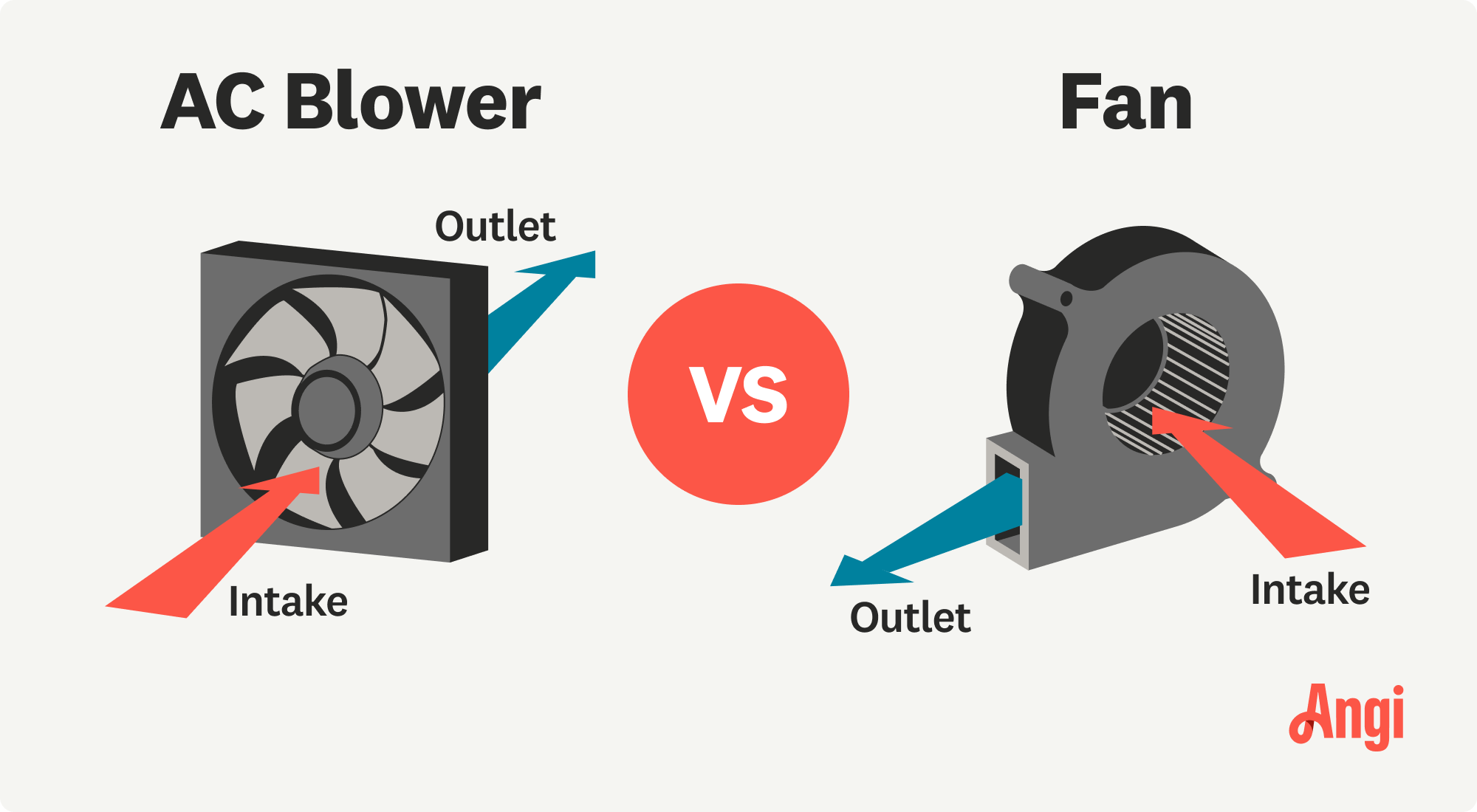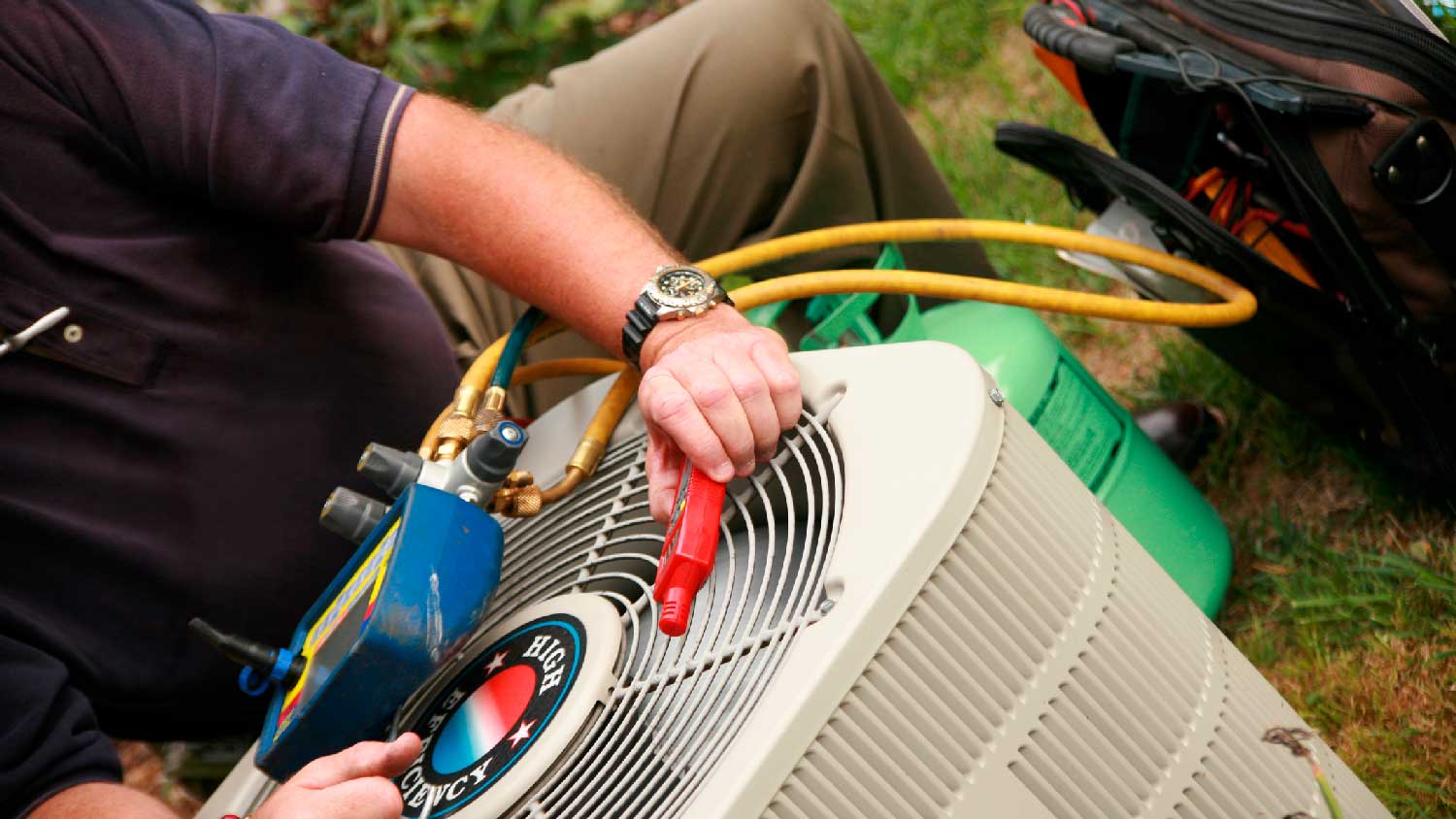
The cost of a new AC unit depends on the size and type. Our guide breaks down AC replacement cost factors so you can decide which option matches your budget.
They may seem similar, but the differences will blow you away


Blower fans move heated and cooled air around a home.
Fans, or condenser fans, cool condenser coils in an AC unit.
Blowers require more pressure, with a pressure ratio of 1.11 to 1.2.
Fans have slightly shorter lifespans of 10–15 years.
Blower replacement costs $300–$900, while fan replacement costs $100–$700.
Your AC is busted, but as you try to pinpoint the problem, you can’t tell if the issue is with the blower or the fan. As it turns out, these two parts aren’t the same thing, and there are actually quite a few differences between a blower versus a fan. Whether your HVAC is in need of a replacement part or you’re just looking for the most effective way to cool a space, here are the key differences you should know between fans versus blowers.
The blower is a mechanical motor that pushes air from the indoor HVAC unit over an evaporator (for cool air) or furnace (for warm air). The blower then pushes that air through the ductwork and into your living space. The fan, or condenser fan, is located in the exterior AC unit and directs air over the condenser coils to cool them down.
| Difference | Blower | Fan |
|---|---|---|
| Appearance | Covered casing | Exposed blades |
| Function | Moving hot/cool air | Cooling condenser |
| Pressure ratio | 1.1–1.2 | Less than 1.1 |
| Power demand | Varies | Varies |
| Lifespan | 10–20 years | 10–15 years |
| Cost | $300–$900 | $100–$700 |

Although both blowers and condenser fans are referred to as “fans,” they don’t exactly look identical. However, blowers and fans are both made of metal and are gray or black in color.
A blower is located on the interior HVAC unit and has a round metal casing or cage in the center that looks similar to a hamster wheel. The rotating impellers are inside the casing. The condenser fan only works with AC, not heating, and you can find it inside the exterior AC unit. It’s often square and looks like a box fan you might have in your bedroom, with the blades visible.
The major difference between a blower versus a fan in an HVAC system is the purpose of each part. A blower moves air in the system over an evaporator coil (to cool the air) or over a furnace’s heating element (to heat the air). Then, the blower pushes this cooled or heated air through your home’s ductwork.
The condenser fan is specifically for air conditioning. This part cools down the condenser coil before hot, pressurized refrigerant enters. The fan is essential for preventing the condenser from overheating.
Blowers and fans use different amounts of pressure to move air. A fan requires less pressure change to move large amounts of air, with a pressure ratio lower than 1.11. A blower uses slightly more, with a pressure ratio of 1.11 to 1.2 to move air.
For comparison, the compressor, which pressurizes refrigerant and pumps it to the condenser coil, has a higher pressure ratio of over 1.2.
Blowers and condenser fans are two of the top energy-consuming parts of an HVAC system, right behind compressors and evaporators. Both blower fans and condenser fans can use 500 watts per hour each, although the total depends on the HVAC model.
For instance, a highly efficient model may have a blower motor that uses only 75 watts per hour. Condenser fan power usage also depends on where the outside AC unit is located. If it’s in a shady spot, the fan won’t have to work as hard compared to a unit placed in the sun.

If you have furnace problems, a heat pump fan that’s not spinning, or AC that isn’t actually cooling down the house, there could be problems with the blower or fan. While calling in a pro for inspections and repairs will help fix the issue at hand, keeping up with maintenance is the best way to avoid HVAC problems.
Here’s a checklist to follow to keep your blower motor running smoothly:
Inspect vents and remove obstacles as needed.
Replace HVAC filters every 90 days.
Inspect blades for cracks and other visible problems once per quarter.
Clean fan blades once per quarter.
Schedule annual inspections and tune-ups.
Follow this schedule for keeping your condenser fan in working condition:
Keep vents open and unobstructed when the AC is running.
Change AC filters at least every 90 days.
Clean condenser coils at least once per year.
Lubricate the fan components annually.
Hire a pro for annual inspections and tune-ups.

Both the blower and the fan should last for the entire lifespan of your HVAC system, although these parts may wear out early if you don’t keep up with regular maintenance. Fans tend to wear out within 10 to 15 years, while a blower should last 15 to 20 years. If the fan wears out around the 10-year mark, it’s better to only replace the fan.
However, if the fan or blower are faulty at 15 years or later, it may be time to consider whether to replace the blower motor and fan or invest in a new HVAC system altogether. Whether you’re due for a part replacement or a whole new system, hire a pro AC installer near you to get your home back to a comfortable temperature as quickly as possible.
If your AC isn’t cooling your home like it should, it’s time to schedule a part replacement. An AC unit fan motor costs $100 to $700, and replacing a blower motor costs $300 to $900.
While AC problems can be an unpleasant surprise, don’t put off replacing these parts. Otherwise, you’ll pay more for bigger repairs. For instance, if you wait to repair a faulty condenser fan, you risk overheating the AC. Then, you’ll have to pay $900 to $2,800 for the cost of replacing the AC condenser.
From average costs to expert advice, get all the answers you need to get your job done.

The cost of a new AC unit depends on the size and type. Our guide breaks down AC replacement cost factors so you can decide which option matches your budget.

Discover the cost to install ductwork. Learn about average prices, cost factors, and tips to save money on your ductwork installation project.

Regularly replacing your HVAC filter regularly is vital for a healthy system. Learn how much an HVAC filter replacement costs with this informative guide.

Tackling unwanted odors from indoor plants can be tricky. Learn how to use a carbon filter in your duct fan to improve air quality.

Learn how to add Freon to your AC unit with our step-by-step guide, and keep your home cool with a properly functioning AC unit.

Discover heat exchanger replacement costs to learn about price factors, labor, and ways to save before hiring a pro or starting your project.